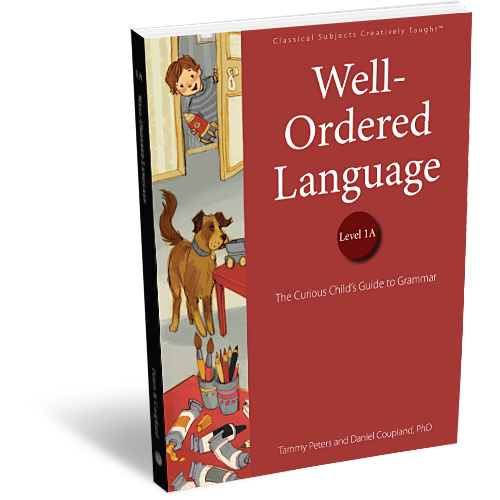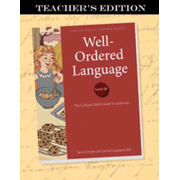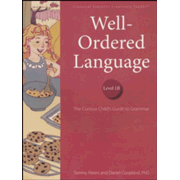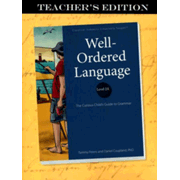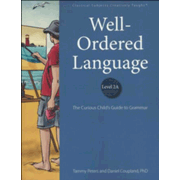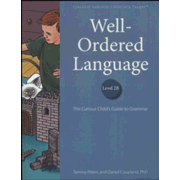Well-Ordered Language (WOL), a grammar series from Classical Academic Press consists of four levels with two courses—A and B—for each level. Level 1 is appropriate for third and fourth graders. Level 2 targets grades four and five. Levels 3 and 4 might be used for grades five through eight. Usually, you will complete both books A and B in one school year.
There are both a teacher’s edition and a student worktext for parts A and B of each level. Although books are printed in black and white, frequent illustrations, plenty of white space, and easy-to-read fonts make them child-friendly in comparison to some grammar worktexts. You will also need the MP3 files with the songs and chants for each level—one set of MP3 files covers both A and B.
The courses are written for classroom use and include many group activities. For Level 1A, homeschoolers can use the book with only one child but will have to skip some activities and adapt others. Teacher's editions for Level 1B and beyond include "Fewer Than Five" adaptations for activities that tell teachers or parents how to adapt the activities for fewer than five students.
Three potential schedules in the teacher’s editions allow flexibility in scheduling. One option is a fast-paced, five-days-per-week option for covering both books in one semester. The two other schedules set you up to complete A and B in one semester each, working either three or four days per week. The four-days-per-week schedule includes some optional activities that might be skipped in the other schedules.
WOL concentrates heavily upon grammar. It uses a very systematic, sequential approach for teaching grammar. Students learn to analyze sentences using a unique system for identifying and marking up parts of speech and their functions within each sentence. You can see short videos with author Tammy Peters showing how the sentences are analyzed for each lesson at www.classicalacademicpress.com/WOL. When you preview this, you should look ahead to at least the video for Chapter 4 to get a better picture of what it looks like past the beginning stages of Level 1.
To learn how to analyze sentences, students memorize definitions of essential elements such as the eight parts of speech and the four classes of verbs through choral recitation. The “songs” are available separately as downloadable MP3 files. I understand the benefit of using songs or chants to master some of the material, but in this case, the style of the “songs” is somewhere in between songs and chants, and it doesn’t seem to be as engaging as either of those genres can be. Also, I question the value of putting simple information into a song/chant format when it is easy to master without doing so. For example, the “Principal Elements” song has the words, “Principal elements are the parts of the sentence that are needed for the sentence to be completed. Subject and predicate are those two parts.” It seems easier to me for children to learn a simple statement saying that a complete sentence requires a subject and a predicate without making it more complicated by adding the song/chant to memorize.
Another point regarding the choral recitation: some children might resist singing alone. Of course, a parent can sing along with a child, but it’s not the same as children doing it together.
WOL was written to support a classical approach to education, and this is evidenced by the logical, analytical approach to learning grammar as well as by the repetition and memorization. The courses require frequent repetition and review so that students master definitions and patterns of analysis. This equips them with the skills to fluently analyze sentences on their own. However, teachers need to project energy and enthusiasm through the sentence analyses and choral recitations, Otherwise, students might get bored with the amount of repetition.
While the courses need to be taught to students, the teacher’s editions walk you through the lessons with explicit instructions, including complete scripting of the sentence analyses. All of this makes it easy even for teachers who are weak in grammar to feel confident as they teach.
Teacher’s editions have student pages with overprinted answers and instructional notes printed in boxes. There are additional teaching pages for oral exercises, games, and sentence analyses, plus pages with optional activities to be completed based upon fables, tales, and/or poems. Note that the work with fables, tales, and poetry includes reading comprehension questions that can be used either orally or for written work. Lessons for fables, tales, and poems for the first level include some hands-on activities and copywork as well as some grammar activities.
There is quite a bit of flexibility in how you use (or don’t use) some of the lesson material. “To the Source” sidebars that appear in both student and teacher books have information about word derivations that you might want to discuss with students. Some grammatical points are explained in the teacher's editions, and some of these explanations might be worth sharing with students. It’s generally up to you to decide how to use this type of information.
To make the lesson material interesting, the books include delightful artwork, a story thread about a family, and excerpts from poetry and literature. For example, in Level 1B, Chapter 2, an excerpt from a Rudyard Kipling story “The Beginning of the Armadillos” is used to teach about the use of subject pronouns. Chapter 1 of Level 3A uses an excerpt from The Adventures of Tom Sawyer to teach about various types of sentences. The complex, rich sentences are much more enjoyable to analyze and learn from than are typical sentences used in most grammar books.
Complete poems are also used in the different levels. The complete poems and lengthier excerpts from some of the books are at the back of both student and teacher books along with biographies of some authors.
Each book is divided into seven or eight chapters, and each chapter will take from one to two weeks to complete. Every chapter introduces a new concept and terms that students need to remember. Chapter introductions conclude with a sentence analysis guided by the teacher to help reinforce what students have just learned. After this approximately ten-minute introduction, students continue with practice and review exercises and activities. On subsequent lesson days for that chapter, students work through activity pages that help them practice applying what they have learned and review key concepts. Daily lessons should take about 30 to 40 minutes to complete. During part of that time, students will be working on their own in their student workbook, but the rest of the day’s class time will be interactive. Those with the time in their schedule can use the optional “Lessons to Enjoy” that incorporate fables, tales, and poems. I highly recommend using these if you can.
Those who want additional practice and/or quizzes can order the optional Extra Practice and Assessments for each volume which is laid out very similarly to the primary lesson material. The PDF for volume 1A, for example, has 165 pages—this is a lot of material! For each chapter, the PDF has additional practice sheets for each section of each lesson, sentences that can be analyzed, an extra Lesson to Enjoy, and a quiz.
Level 1A teaches four kinds of sentences, subjects and predicates (introductory level), nouns, verbs, adverbs, adjectives, direct objects, subject pronouns, and helping verbs. Level 1B builds upon 1A, adding object pronouns, prepositional phrases (adverbial), compound subjects, subject/verb agreement, compound verbs, and compound direct objects.
Level 2 begins with a quick re-teaching of the four kinds of sentences, subjects, predicates, helping verbs, and basic punctuation. Students could begin at this level without first completing Level 1. It is important to note that sentence diagramming is introduced with Level 2 and continues through Levels 3 and 4, so even though diagramming does not show up in Level 1, it is an important part of future volumes. Level 2 introduces sentence diagrams in the first chapter and builds quickly from diagrams of simple subjects and predicates to include diagrams with adjectives, adverbs, possessive nouns, predicate adjectives, predicate nominatives, and prepositional phrases. Level 2 also teaches topics such as interjections, adjective clauses, commas, and possessive pronouns.
Level 3 continues reviewing through all previously covered grammatical concepts while adding topics such as verbals, implied subjects, rhetorical questions, verb tenses, subject-verb agreement, and more complex punctuation and usage.
Level 4 reviews the eight parts of speech and their functions, as well as punctuation, sentence structure, and other topics, but everything shifts to a higher level of complexity and requires more thoughtful analysis. For example, Chapter 7 asks students to analyze and diagram the tricky sentence, "Awkwardly, the nervous lady who was near me grabbed my arm" (p.145).
Summary
Well-Ordered Language is a very interactive curriculum that involves reading, writing, speaking, and listening along with choral recitation and some hands-on activities and games. While parts of the lessons are tightly structured, many lesson activities allow for discussion or open-ended responses.
The challenge of choral recitation without a group might be a limiting feature for some homeschoolers. WOL should work best for group classes, but it should also work well for homeschooling parents who have the time to devote to teaching the lessons one-on-one.





